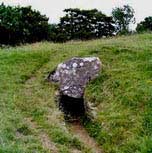|
Uley in
Gloucestershire
|
 Located two and a half miles northeast of Dursley, off the banks of the river Stroud, Uley and its neighboring towns were known as the cloth-making region of England. During the fifteenth century, rumors of the River Stroud having soft water was believed to responsible for the excellent quality of their dyes, especially the vivid Stroud Scarlet and Uley Blue. Yet, studies have proven that the water had nothing to do with it. The stories were spread by locals to deter competitors from trying to discover trade secrets, such as careful, consistent testing of batches and other well-kept techniques. Today only a fraction of the once thriving industry remains. Reduction in the industry resulted in a drop in the population. Former loyal workers and their families began immigrating to places like America, Canada, and Australia. Despite the loss, the industry has left its imprint on the town. The names of the local fields have links back to the mills and the wool industry. Most of the local fields have the word rack in their name because of the object over which the cloth is stretched.
Yet there is more to this town then just the tattered remains of what the cloth industry has brought and left. On of the more awesome Iron Age Forts in England, Uley Bury, spans over 23 acres with much of the remains still left to be excavated. Another of Uley’s great underground wonders is Uley’s Barrow, also known as Hetty Pegler’s Trump. The barrow is a 120 feet long, 85 feet wide, 10 feet high ancient Roman burial chamber. The remains of which over fifteen skulls have been found.
Located two and a half miles northeast of Dursley, off the banks of the river Stroud, Uley and its neighboring towns were known as the cloth-making region of England. During the fifteenth century, rumors of the River Stroud having soft water was believed to responsible for the excellent quality of their dyes, especially the vivid Stroud Scarlet and Uley Blue. Yet, studies have proven that the water had nothing to do with it. The stories were spread by locals to deter competitors from trying to discover trade secrets, such as careful, consistent testing of batches and other well-kept techniques. Today only a fraction of the once thriving industry remains. Reduction in the industry resulted in a drop in the population. Former loyal workers and their families began immigrating to places like America, Canada, and Australia. Despite the loss, the industry has left its imprint on the town. The names of the local fields have links back to the mills and the wool industry. Most of the local fields have the word rack in their name because of the object over which the cloth is stretched.
Yet there is more to this town then just the tattered remains of what the cloth industry has brought and left. On of the more awesome Iron Age Forts in England, Uley Bury, spans over 23 acres with much of the remains still left to be excavated. Another of Uley’s great underground wonders is Uley’s Barrow, also known as Hetty Pegler’s Trump. The barrow is a 120 feet long, 85 feet wide, 10 feet high ancient Roman burial chamber. The remains of which over fifteen skulls have been found.
|
|